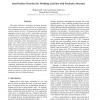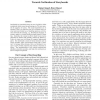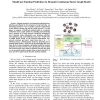21 search results - page 4 / 5 » Learning Spatiotemporal Graphs of Human Activities |
ISWC
2003
IEEE
13 years 11 months ago
2003
IEEE
Context-aware computing describes the situation where a wearable / mobile computer is aware of its user’s state and surroundings and modifies its behavior based on this informat...
CVPR
2012
IEEE
11 years 8 months ago
2012
IEEE
This paper addresses recognition of human activities with stochastic structure, characterized by variable spacetime arrangements of primitive actions, and conducted by a variable ...
IROS
2008
IEEE
14 years 5 days ago
2008
IEEE
— Human control of high degree-of-freedom robotic systems, e.g. anthropomorphic robot hands, is often difficult due to the overwhelming number of variables that need to be speci...
FLAIRS
2008
13 years 8 months ago
2008
Storyboards are commonly known as rows of pictures, which exemplarily sketch scenes in performing arts. The rows specify the sequence of scenes. The scenes themselves are illustra...
ICDM
2010
IEEE
13 years 3 months ago
2010
IEEE
Human emotion is one important underlying force affecting and affected by the dynamics of social networks. An interesting question is "can we predict a person's mood base...



